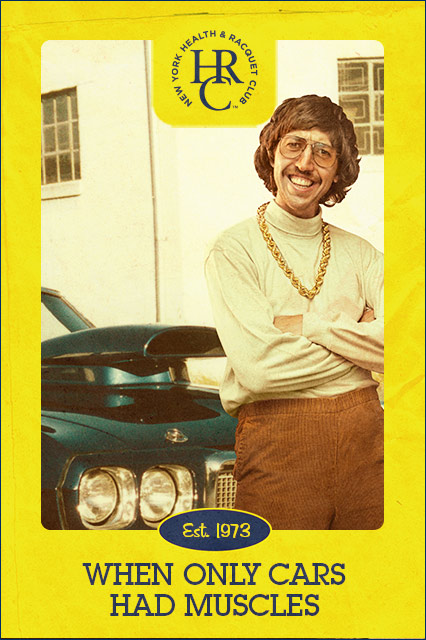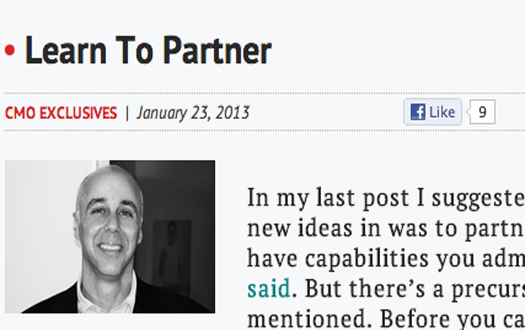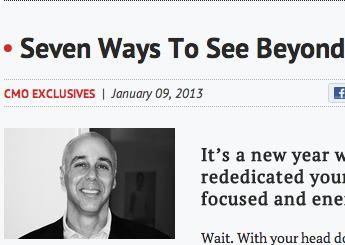By
Mark DiMassimo | 09/05/2017 | in

I can’t remember when I first became fascinated with brands, but I know I was just a young child. Back then, Cheerios and Wheaties, Esso and Shell, Little Friskies cat food, Avis Rent-a-Car, were like cartoon characters to me. They had distinct personalities and I felt like I knew them, just like I knew the characters in my favorite shows.
From the brands I learned to love on TV to the more mature brands I later grew to love. The rock bands I worshipped. The threat and allure of Disco, Punk, New Wave and beyond. The religions I was pitched at school, in the streets and at my front door. My first credit cards from Citibank and American Express. Nike and Apple.
What art form gives you all the senses to work with? Sight. Sound. Smell. Hearing. Touch. And story, imagination and emotion too?
The dream began to form in me of building brands the way Picasso made paintings, the way Frank Lloyd Wright made buildings, the way Edison made inventions. Could I give thought to every touch point, and express a distinct and attractive personality that would remain consistent without ever being boring or trite?
I wanted to learn from the best, so I went to work for the best in the business. I chose as my clients entrepreneurial masters of brand building. I never thought of myself as the master, but only as student and servant. I practiced my craft obsessively. I stayed up nights writing. I read every book. I invited my heroes to lunch, always trying to learn a bit more, to add another key.
Yes, all of that time, I was a direct marketer. All of that time, I was measured by how well my work pulled, by beating controls, by winning tests, by conquering the A/B splits.
I learned all the tricks, but my greatest trick of all and the most effective was the ability to evoke emotion through brand. “A great brand idea is the ultimate response device,” I said. And I proved it repeatedly.
I’ve watched a lot of direct brands and careers die since then. Simultaneously, I’ve watched the great direct-led brands become the leading brands of our time. American Express, Apple, Amazon, Airbnb … and that’s just the A’s!
Remember, if you are in the business of selling directly, don’t merely sell. Build a rich, evocative, emotional brand. Use every touch point to differentiate. Err on the side of too much personality. Crush apathy. Make objectivity impossible.
Just as I do, so many wildly successful marketers remember their first journey of brand discovery as the true commencement of their marketing careers. They look back on that quest to uncover the insight that can change and organize everything going forward. The way they followed the data to the customer journey and came back with the golden insight, then mined that inspiring idea for all it was worth.
It’s a revolution in a brand, in a business and in a marketer’s career. In fact, many marketers have told me, “That’s when I first felt like a real marketer.”
Let’s do marketing for real. Let’s build a masterpiece.
By
Team DIGO | 09/24/2015 | in
There was once a man who refused to give up smoking until it was proven beyond a shadow of a doubt that smoking caused disease.
He didn’t live long enough to see the proof.
Today, there are direct (digital, mobile, SAAS, subscription, e-commerce, club…) marketers who refuse to improve their marketing success with an insight-driven multi-channel strategy until the perfect attribution model has been developed.
Every day, another one is buried by a marketer with a more reasonable measure of proof.
Is overall marketing efficiency your ultimate measure? Is making one dollar of marketing spend return two or three or four times as many customers your objective?
If so, you are an optimizer.
If you prefer perfectly attributable though small gains in discrete channels, then you’re an incrementalist.
Optimizers eat incrementalists for lunch.
Sometimes, in very big places, incrementalists work in the middle of a pyramid with optimizers at the top. Even so, they can only swim so far up before they hit a ceiling. Too late, they find that the open market is not a very friendly place for an incrementalist.
Why do incrementalists do it to themselves? Is it because they are trading upside for certainty? Is being sure more valuable to them than being successful? Is being right worth more to them than results?
Or did they just swallow a less intelligent idea of what it is a marketer is supposed to do?
Well … enough musing about the incrementalists, much as I would like to convert as many of them as possible to a life of success beyond explanation.
We are for the optimizers.
By
Team DIGO | 09/27/2013 | in

Gothamist
New York Health & Racquet Club (NYHRC) put fitness on the map in NYC when it first opened its doors in 1973. Now, of course, New Yorkers have more exercise options than NYC has pizza joints. Yet they keep coming back to NYHRC, the original NYC health club, where they feel part of a tight-knit community of health-conscious people in pursuit of fitness and vitality.
At any of NYHRC’s nine Manhattan locations, virtually any fitness need or interest can be met, whether on your own and taking advantage of the well-equipped gym floor, or with the guidance of seasoned group fitness instructors and certified personal trainers.
NYHRC is truly in a class by itself, with amenities you won’t find at many other health clubs, including saltwater pools, squash and racquetball courts, basketball courts, a beach club and a yacht, perfect for beautiful sunset cruises around Manhattan.* (more…)
By
Team DIGO | 09/25/2013 | in
 Just wrote the welcome message for our DiMassimo Goldstein employee Intranet. Thought I’d share:
Just wrote the welcome message for our DiMassimo Goldstein employee Intranet. Thought I’d share:
Welcome to the Growth Agency Network.
If you only remember three words, remember these: EVERY TOUCHPOINT MATTERS
In the center of you there is a double helix of DNA that sets in motion who you become. Clip a fingernail and this same code is there.
In the center of every experience is the truth of the brand. If the reception desk is boring, the brand is boring. If the invoice has no charm, the brand has no charm.
An inspiring receipt. A stylish notepad. A creative collection letter. A box with spots. A one-page owners manual.
Empires have been built on such small things as these.
If it is, it is a part of the brand.
Brand. Driven. Growth. That’s four, five and six. That’s how we do it.
Banner, hang-tag, balloon. Truck to television commercial. If we can do it, we can make it deliver the brand.
Here we tend to these individuals we call brands. We grow and evolve them. And we can tell you what is in the fingernail, before you clip it. (more…)
By
Team DIGO | 01/28/2013 | in

Jeff Pundyk, CMO.com
In my last post I suggested that one way to let new ideas in was to partner with those who have capabilities you admire. Partner to learn, I said. But there’s a precursor that I should have mentioned. Before you can partner to learn, you must learn to partner.
(more…)
By
Team DIGO | 01/10/2013 | in

Jeff Pundyk, CMO.com
It’s a new year with new goals, and you have rededicated yourself to driving results. You are focused and energized. Head down.
Wait. With your head down, you just might miss the signs of change, the subtle shifts that signal that your customers are operating in a different way, that competition is coming from someplace unexpected, that the nature of your opportunity has changed.
(more…)
By
Team DIGO | 01/08/2013 | in
People get ahead of advertisers, and when they do there is opportunity for change agents like you to seize advantage.
In this case, a few words from the very smart to the wise should be sufficient to get some productive conversations going.
Mary Meeker of venture capital firm Kleiner Perkins analyzed the percentage of time spent on each medium and compared it to ad spend. She found consumers spend 26% of their media consumption time online, while marketers spend 22% of their ad budgets on digital. TV should fare better, with consumers spending 43% of their media time watching TVand marketers spending 42% of their ad budgets on the thing we used to call the “tube.” Mobile is the area best poised for geometric growth, as consumers are now spending 10% of their time with mobile, while marketers are only spending a wee 1% of their ad budgets there.
(more…)
By
Team DIGO | 01/08/2013 | in

DIGO client AliveCor has been featured in many publications subsequent to the recent announcement of FDA approval for their life-changing heart monitor device. The AliveCor Heart Monitor makes it easy to do a medical quality ECG with an iPhone. (more…)







